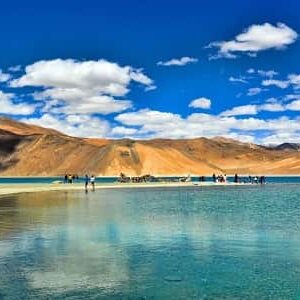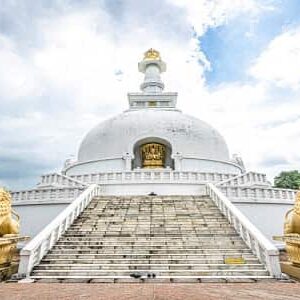Tso Moriri or Lake Moriri or “Mountain Lake”, is a lake in the Changthang Plateau of Ladakh in India. The lake and surrounding area are protected as the Tso Moriri Wetland Conservation Reserve. The lake is at an altitude of 4,522 m. its a most beautiful lake located only 166 km from Leh and 450 km from Manali
Tso Moriri is situated in the Changthang region of Ladakh, in the Indian state of Jammu and Kashmir. It is about 240 kilometers southeast of Leh, the capital of Ladakh.
Tso Moriri is a hidden gem in the Himalayan region of India, offering a tranquil and awe-inspiring landscape for those willing to venture into this remote part of Ladakh. It is a popular destination for nature lovers, trekkers, and adventure seekers looking to explore the natural beauty and wildlife of the region.
Table of Contents
ToggleTso Moriri Tourism
the high- altitude Tso Moriri Lake is lower than 250 kilometers southeast of Leh. adjoined by lofty mountains, this serene lake is about,000 measures above ocean position. Tso Moriri is roughly 29 kilometers long and over to 8 kilometers wide. Tso Moriri attracts a range of wildlife, including migrant catcalls, marmots and infrequently the Tibetan wolves.
he lake is the perfect place to spend some time down from the hustle and bustle of thecity.While the reflection of snow- sheathe mountains immersed in the pristine waters of the lake calm your soul, the fantastic migrant catcalls flying above the majestic lake will make you fall in love with nature.
The lake is girdled by high mountains, making it a retired gem in the cold desert land of Ladakh. It’s an ideal trip destination for an odd rubberneck as well as those who wish to explore the untouched beauty of Ladakh.
Witness the changing tinges of the lake and fall in love with nature each over again with a trip to Tso Moriri. Pack your bags, pick up your camera and set off on your trip to Leh Ladakh to live and capture.
Tso Moriri remains substantially firmed , extremely cold conditions with no options to stay around the lake. In April types, it starts to melt and starts transubstantiating into the beautiful multi tones of blue colors off the props. also May, June, July and August is the peak sightseer season but as compared to Pangong Tso it gets lower number of sightseer.
The lake is home to nearly 34 species of catcalls, out of which, 14 are water catcalls. Some of the catcalls which you can spot at the lake are balck- necked cranes, brown headed suckers, black necked grebe and great crested grebe. Mammals like Tibetan Gazelle, Himalayan Blue Sheep, Tibetan Ass and Great Tibetan Sheep also live in close propinquity. Snow leopard and Tibetan Wolf also live in the near surroundings.
On the western bank of the lake stands the Korzok Monastery, which is 400 times old and houses about 70 monks. It contains the statue of Shakyamuni Buddha along with Tibetan Buddhist oil.
The Korzok Gustor Festival is celebrated at the friary and is marked by several rituals, one of which is masked balls called Chham.
he fineness and beauty of the lake with the colossal mountains in the background and catcalls flying over will leave you bedazzled.
also, the remote position enhances its beauty with the appearance of numerous migrant catcalls and attracts a lot of excursionists in hunt of exhilaration and adventure. You can enjoy the graphic view of Tso Moriri, which is a sight to behold and to keep safe in your memory ever.
Best Time to Visit Tso Moriri Lake
The best time to visit Tso Moriri Lake in Ladakh, India, largely depends on your preferences and the type of experience you’re seeking. Here’s a breakdown of the different seasons and what they offer:
Summer (May to September):
- Best for Most Travelers: This is the most popular time to visit Tso Moriri. During the summer months, from May to September, the weather is relatively mild and the lake is accessible. Daytime temperatures can range from 15°C to 25°C (59°F to 77°F).
- Wildlife and Scenic Beauty: This period is ideal for birdwatching, as migratory birds flock to the lake, and the surrounding landscape is lush and green. You’ll have a better chance to spot wildlife like Tibetan wild asses and marmots.
- Camping and Trekking: Summer is perfect for camping and trekking around the lake, as most trekking routes are open and conditions are favorable.
Autumn (September to October):
- Quieter and Pleasant: Early autumn can be a great time to visit if you want to avoid the crowds that come during the peak summer season. The weather is still pleasant, with daytime temperatures gradually cooling down.
- Fall Colors: The fall foliage in the region can be stunning, with the landscape taking on vibrant shades of red and gold.
How to Reach Tso Moriri Lake
Reaching Tso Moriri Lake in Ladakh, India, involves a journey through the stunning but challenging terrain of the region. Here are the primary routes and transportation options to reach Tso Moriri:
1. From Leh (the capital of Ladakh):
- By Road: Leh is the most common starting point for a trip to Tso Moriri. You can hire a private taxi or use shared taxis to reach the lake. The journey to Tso Moriri from Leh takes approximately 6-8 hours, covering a distance of around 240 kilometers. The road passes through picturesque landscapes and high mountain passes, such as Chang La and Mahe Bridge.
- By Bus: Limited bus services are available from Leh to Korzok, a small village near Tso Moriri. Bus schedules can be irregular and may not be the most convenient option.
2. From Manali:
- If you are coming from Manali, you need to follow the Manali-Leh Highway (NH3) first to reach Leh. Once in Leh, you can follow the route mentioned above.
3. From Keylong or Sarchu:
- If you are coming from Keylong or Sarchu, you can also reach Leh first and then proceed to Tso Moriri.
4. By Air:
- The nearest major airport to Tso Moriri is Kushok Bakula Rimpochee Airport in Leh. You can fly to Leh from major cities like Delhi, Mumbai, and Srinagar. From Leh, you can arrange for transportation to Tso Moriri.




